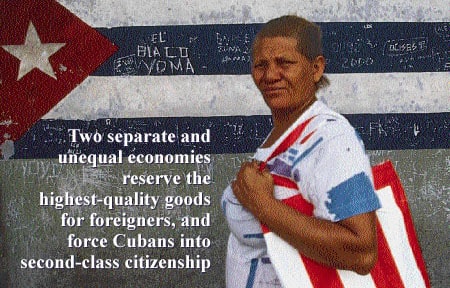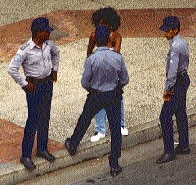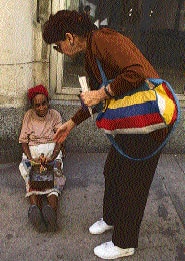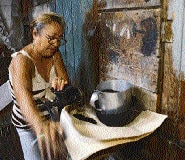by Amy Martin

Caridad walks Havana’s famous sea wall, the Malecon, in tall orange pumps. She has squeezed her skinny body into an electric-blue spandex body suit. Her arm is raised, her hip turned out provocatively. She scans the oncoming traffic, ignoring the 40-year-old Fords, Chevys, and Dodges puttering off into the sunset, crammed full of people on their way home from work. It’s the newer cars she’s concerned with, the ones that carry tourists.
Caridad makes $20 – $30 per customer, more than the average Cuban can make in four months. Since the collapse of the Soviet bloc, the need for U.S. dollars is so high and the ways to obtain them are so few, it’s not surprising that the sex trade is flourishing in Cuba. “There are babies out in the street now,” Caridad says, shaking her head. “Young girls of 11, 12, 13.” Caridad’s own daughter is eight; Caridad is 33.

Almost all her customers are foreigners. “There are a few nice ones, but most are pigs,” she says. She is equally pithy in her description of Fidel Castro. “That son-of-a-bitch should be in prison,” she says. “He’s the cause of our problems.” I ask about the U.S. embargo. She laughs. “The bloqueo (embargo) is the only thing keeping him alive.”
Prostitution has boomed in Cuba since the government opened the door to foreign investors and tourists in the early 1990s as a way of salvaging the economy after the Soviet Union fell and Cuba’s preferential trade agreements withered. All over Havana, young women can be seen walking arm-in-arm with foreign men twice their age. The beaches have been turned into brothels. Websites advertise the virtues of Cuban prostitutes: young, beautiful, and dirt-cheap.
Caridad has been sent to prison more than once. “I don’t understand why I go to jail and the men, the customers, don’t,” she complains. “This is my body. I should be able to do with it what I want.”
The belief that Cubans girls and women are HIV-free is another of their selling points to foreign men. This myth is based on Cuba’s policy of testing the entire population for HIV and locking up anyone who tests positive in a sanatorium. “Residents” of the sanatoriums, which are surrounded by barbed wire and armed guards, must prove they will not engage in promiscuous behavior before they are allowed to leave. Even then, they are accompanied by armed guards on their first furloughs. Later, they may earn the right to live unsupervised in mainstream society.

It is at the expense of human rights that Cuba has been able to achieve a lower per-capita rate of death from AIDS than any other country in the hemisphere. But according to Mark Wojcik, an assistant professor of law at Chicago’s John Marshall Law School, and an AIDS expert, the confinement policy has led many Cubans and visiting foreigners to assume they and their sexual partners do not need to protect themselves against AIDS. “The policy has backfired,” says Wojcik. “People think ‘you’re not locked up, you must be OK.’ They don’t use condoms.”
As Cuba opens itself up to foreign tourism, this attitude becomes increasingly deadly, particularly for sex workers on the island. The rise in prostitution is certain to affect the incidence of AIDS in Cuba, but Wojcik is not aware of any special HIV testing or AIDS prevention programs aimed at prostitutes.
Caridad’s bitterness toward the revolution is increasingly common in Cuba today, and may come as a surprise to feminists from capitalist countries. We’re used to hearing right-wingers like Jesse Helms and the late anti-Castro activist Jorge Mas Canosa rail against Castro, not women like Caridad. But in Cuba, everything is reversed. The conservatives and the communists are the same people. You can get thrown in jail for being too much of a capitalist. Revolution is an institution. Socialism is sold on billboards. Owning a business is a rebellious act.
“Everything is difficult here.”
Sonia* has no energy left for rebellions of any kind. What matters is finding something to eat. “Todo es dif’cil aqu'” (Everything is difficult here). She repeats the phrase like a mantra as she explains Cuba’s confusing and inefficient economy. Fifty-one years old, divorced for many years, and unemployed, Sonia lives in a small dark apartment in Centro Havana, one of the city’s poorer districts. Her home is a miracle of conservation and make-do efficiency. A bucket is placed under the bathtub faucet to collect spare drips in case the water runs out. She uses only one of her three cooking pots to cook things in oil: If she kept pouring oil in and out of different pots, much more would be wasted. Almost nothing is thrown away. Potatoes are eaten even if they’re soft; old shampoo bottles become canisters for flour and sugar.

Sonia’s tattered ration card lists rice, beans, bread, cooking oil, and a few other basic items. “This is supposed to last through the month,” she says, “but it lasts two weeks at the most.” Soap, eggs, coffee, detergent and toothpaste are in especially short supply, often not appearing at the rationing stations for months at a time. Fruit, meat, and many other products are no longer available at all through the ration system. To get these items you have to go to the agri, the farmers’ market, where prices are very high. Or you have to go to the shoping, the stores where goods are sold for U.S. dollars — simply not an option for many Cubans. “I have no family abroad sending me dollars, so I just have to manage,” she says.
For decades, Cuba’s economy was subsidized with imports from Eastern Europe and the Soviet Union, which were paid for by selling those countries Cuban products — mostly sugar — at above-market prices. In 1989 imports from the USSR alone were worth $5.5 billion. By 1991 that number was reduced to a little over $1 billion. The Cuban government has been reluctant to release figures, but experts believe that between 1989 and 1993 the island’s Gross Domestic Product (GDP) shrank some 40 – 50%. Cuba exported 80% less in 1993 than it did in 1989. Imports during that period fell by the same percentage.
In the early 1990s, in a desperate attempt to draw hard currency into the nation’s battered economy, Castro was forced to permit significant levels of foreign investment. The tourist trade this investment spawned, however, was conducted in U.S. dollars, which Cubans were not legally allowed to possess. Almost immediately, two separate and unequal economies developed, one for Cubans, in which transactions were conducted in pesos, and one for tourists, in which they were conducted in dollars. In effect, the dual system reserved the highest-quality goods for foreigners, and forced Cubans into second-class citizenship in their own country.
As the state struggled to provide basic necessities, resentment grew and the underground economy flourished. Finally, the possession of dollars was legalized in 1993.
This didn’t put an end to the parallel economies, however. It cemented them in place. Suddenly, Cubans found themselves divided into two distinct classes: those who had dollars and those who did not. People who had been receiving illegal remittances from relatives in Florida, found themselves on top of the heap, while faithful revolutionaries were stranded, awash in useless pesos. And still the infrastructure continued to erode. In the summer of 1994, after suffering through frequent blackouts lasting 10 hours or more, a series of riots erupted. This led to a spontaneous exodus, as more than 20,000 Cubans took to makeshift boats and rafts in an effort to flee the country.
Officially, the current exchange rate is 23 pesos per dollar. Estela* is a doctor who earns what is considered a good monthly salary of 300 pesos. That’s $13. If she goes to a government-owned store that does business in pesos, a pair of jeans will cost her at least that amount — 100% of her monthly salary or more. A pair of underpants? Around 10%. A single pencil could easily cost 3% of her monthly salary — the equivalent of $125 for an American earning $50,000 per year. And Estela is better off than most Cubans. Her salary is twice the national average.
This economic crisis, euphemistically called a “special period” by government officials, has been as damaging on a national level as it has been for individuals. Many Americans have long looked with envy at Cuba’s free, high-quality, universal healthcare system. Sadly it, too, is now going downhill. With supplies and medicine available to perform no more than a fraction of needed surgeries and other medical procedures, Cubans are forced to use family connections and bribes to get medical attention. For many, it is reminiscent of the Batista days, when only the rich had access to doctors and medicine.
Undoubtedly, the U.S. embargo is partly to blame for this situation, particularly for the lack of medicines. Cuba is 90 miles away from the most affluent economy in the world and is forbidden access to it. The country’s natural trading partners in the Caribbean and in Central and South America have been pressured by the United States not to trade with Cuba.
The health system is also rotting from the inside, at a time when collapsing countrywide infrastructure makes it more vital. Near-epidemics of bacterial diseases such as dengue fever have been linked to improper treatment of drinking water, for example. Power is cut in the middle of operations.”I would never go to a hospital these days,” says one woman. “They can’t even clean the instruments properly anymore. You walk out with more diseases than you had when you went in.”
The out-of-whack economy also threatens to undermine the nation’s prized education system. Over the years, the universities of revolutionary Cuba have trained an impressive group of high-quality professionals. Women have been primary beneficiaries, becoming doctors, professors, engineers and scientists in unprecedented numbers. But professional jobs are scarce these days. The new economy favors instead service workers and street hustlers. Engineers work as taxi drivers, teachers clean hotel toilets. Many young women aspire to become tourist guides, receptionists, or bartenders — all jobs that provide access to dollars through tips. In this environment, even when people want to obtain a professional degree, it seems impractical to do so. Why study for years to become a doctor when your reward is to work in dismal surroundings for little pay?
Despite the emphasis on tourism, Cuba’s economic precariousness means that buildings throughout Havana are crumbling or in ruin. Architects around the world are alarmed by the destruction of so many historically significant structures. The declining housing stock, however, is of concern for more than aesthetic reasons. For example, Estela, the physician, has been legally divorced for years, but is forced to continue living with her husband because neither of them can find anywhere else to live. Her situation is increasingly common.
The housing shortage is exacerbated by a recent influx of immigrants from the provinces. For the first 30 years of the revolution, Cuba managed to prevent slums from growing around its cities. But now tourists with dollars are drawing people in from the countryside. In Havana, friction is already evident, and a growing number of people blame their inability to find jobs and housing on the new arrivals. “All the prostitutes are from the rural areas,” complains one woman. “They sell themselves for a dollar or an ice cream cone.”The Cuban government has failed to articulate any clear long-term plan for the economy, leading Cubans and foreigners alike to conclude that there is none. These days, the government appears to be guided by survivalism, not socialism. Indeed, it is hard to see how Cuba would have survived as a socialist state for as long as it did without Soviet aid.
Moreover, it isn’t at all clear that Cubans, particularly Cuban women, will be much better off once the embargo is lifted. As the experience of many Caribbean nations shows, a tourism-oriented economy offers a paradise only to tourists. While new tourist hotels are built in the city center, the government insists that there are no bricks or plaster for Cubans to repair their homes.
The increasing foreign presence is also directly linked to the increase in prostitution. The sex trade has become one of Cuba’s main attractions for foreign visitors. These women and girls are at the cutting edge of Cuba’s new market-based economy.
Feministas or Fidelistas?
Local prostitution and sex tourism from the U.S. were also big problems in the 1950s, under Batista. But when Castro took over in 1959, the Federation of Cuban Women (known as the FMC, Federacion de Mujeres Cubanas), the official women’s organization of the Revolution, stepped in, setting up rehabilitation homes and providing job training for former prostitutes. Now, with the prostitutes back in business, it might seem the country has come full circle. But the situation is “totally different” today, claims Rita Pereira, a member of the FMC staff. Sitting in her comfortable office at FMC headquarters, one of the few well-maintained buildings in Havana, Pereira maintains that, unlike the prostitutes of the 1950s, those of the 1990s turn to the trade not in order to survive, but merely as “a way to live better” during a time of economic crisis. But isn’t this always the case? The underlying question is overlooked: What are the roots of this economic crisis? What can be done about it? For government officials like Pereira, the answer is simple. The cause of the crisis is the embargo. The analysis ends there.
This one-dimensional thinking is nothing new at the FMC. The organization has often chosen to follow the party line rather than to protect women. Violence against women, to take one example, has been ignored, even flatly denied, for decades. Sociologists Lois Smith and Alfred Padula report in their book Sex and Revolution: Women in Socialist Cuba (Oxford University Press: 1996) that, at a 1993 conference, “Ana Violeta Castaneda of the FMC publicly annaounced that ‘domestic violence is not a problem in Cuba.'” Castaneda also told Smith that “she would be surprised if there were more than ten cases of rape nationally each year in Cuba.” Rape and domestic abuse, the FMC insisted, were capitalist problems.
Recently, however, the FMC has begun to change its tune in this regard, perhaps in an attempt to improve the organization’s current image as a bastion of old-guard apologists for the regime, out-of-touch with the concerns of Cuban women. Pereira says members of the FMC are making plans for a study of violence against women. (Spousal abuse is reportedly on the increase since the economic downturn.) But it will take more than a study to win back women like Mariana,* a thoughtful 40-year-old who thinks the FMC is “run by a bunch of shameless criminals.”
This opinion would have been unthinkable in the early years of the revolution, when the FMC was in its prime. The organization played a significant part in the famous literacy campaign of 1961. It helped women gain power in the workplace and in government, and shaped the progressive family code of 1975. But despite these achievements, the FMC has always been a government vehicle, the one and only women’s organization allowed to exist in Cuba, and run from the top down. In the final analysis, FMC leaders are Fidelistas first and feministas later, if at all.
The insistence on party unity over critical discourse is perhaps the biggest hurdle facing the advancement of women’s issues in Cuba. Any line of thought that might lead a woman to criticize, or even question, the party is simply not allowed into the debate. Although the revolution has helped women in a number of ways, it has also been traditionally patriarchal in its treatment of them. Arguments for woman-friendly labor laws have been cast in terms of protecting the nation’s baby-makers. Women have been encouraged to join the “productive” workforce outside the home, a mandate that ignores the millions of hours of housework, child-rearing, and general family care for which women are still primarily responsible.
The revolutionary government has sent a host of mixed messages to women. It has simultaneously violated women’s human rights and granted them a fuller citizenship than they’ve ever had before. It has assumed a degree of protective ownership over women’s wombs while simultaneously codifying their right to healthy reproductive choices. It has devalued the work women do in the home while at the same time encouraging men to help out.
It is unlikely that this ambivalence was an accident. From the beginning, party leaders recognized women’s power. They knew they needed them and their labor to build a successful socialist state. But they also feared this power. Feminism, after all, is about as revolutionary as you can get. The solution? Give women some of what they want (health care, reproductive freedom, education), but forbid them to think in feminist terms. Keep women happy, but make sure the only revolution they care about is the one led by Fidel.
These tactics have succeeded in limiting the development of an indigenous brand of woman-oriented thought and activism. Even women who lead feminist lives and do feminist work often don’t see their struggles as connected to patriarchy. Sandra Ceballos, an artist whose work would be described as feminist outside of Cuba, says she is uncomfortable describing herself in feminist terms. Another talented young artist, Aime Garcia, agrees. “I don’t really think about those issues,” she says. “I just want a place to make my art.”
Facade of Freedom
Cuban women tend to talk more about the repression imposed on all Cubans by the government than about female-specific issues. “We are not free,” Beatriz* says. In her small thatch-roofed home in the countryside, preparing a modest dinner of rice and beans for herself, her husband, and her brother-in-law, she describes the freedoms she lacks. She and her husband cannot own the land they work every day. They must grow what the government tells them. They desperately need dollars, but can’t sell the produce from their fruit trees unless they apply for a special permit and pay a tax they could never afford.
Beatriz would like to travel, but she can’t leave Cuba without a special letter of invitation from a foreigner. And even if she had such a letter (and the money for a plane ticket), she doubts the government would let her go. She has to watch what she says in front of the neighbors: Someone might tell the police she was criticizing the government, and she could end up in jail. She has warned her nine-year-old daughter not to repeat at school anything she hears at home that could be construed as incriminating.
The government goes to great lengths to create the appearance of democracy. Cubans regularly “elect” representatives to government assemblies, but many believe the elections are a farce. “Local party members come and knock on your door,” says Janet,* a 44-year-old elementary school teacher. “They don’t leave you alone until you come vote.” In Cuba’s latest elections, citizens voted directly for members of the national assembly for the first time. The only problem, explains Janet, was that there were only as many candidates as there were seats. “No one could lose,” she says with a sardonic smile. “They were all handpicked from the top.” Insult is added to this injury by glossy new billboards proclaiming, in bright red letters: “Elections 1998: A colossal victory for the people.”
The people’s deep cynicism regarding the process is never discussed in the media, since government control is complete, and often ruthless. Amnesty International has documented the persecution of many journalists in Cuba. Some have been imprisoned, others exiled; many have been physically attacked. In the mid-1990s, a group of women in communications formed an organization called “Magin” (image and intellect), which worked to bring a gender perspective to the mass media. The FMC, threatened by the existence of any women’s group other than itself, and by Magin’s overtly feminist message, directed the group of 170 women to disband.
The Promise of the Past
The reality is even more depressing in light of what the revolution might have been, and perhaps, in the beginning, wanted to be. In many respects, women have had cause to believe in the revolution. The healthcare system, for instance, radically improved the lives of millions of Cuban women. Smith and Padula state that “for women, the new health system was arguably the most successful innovation of the Cuban revolution,” not only because women could count on good health care for themselves and their families, but also because the system was “largely staffed by women — doctors, nurses, researchers, practitioners, and volunteers.” Women took advantage of free education as well. Cuba’s literacy rate is among the highest in Latin America, and its infant mortality rate the lowest, although this could change if the economic crisis continues.
Advances in reproductive health have been particularly encouraging. Women who choose to become mothers have had access to free, high-quality prenatal and neonatal care. Those who do not want to be pregnant can get inexpensive, safe abortions (around 40 percent of all pregnancies have ended in abortion since the mid-1970s). The population is now more educated about sex than before, and single motherhood is accepted as a legitimate way to raise a family.
The revolution has also helped to change long-held social prejudices. “A woman doesn’t feel like she has to have a man anymore,” says one woman. “In fact, she may feel like she’s better off without one.” Racism is still alive in Cuba, but not in its the institutionalized, government-sanctioned, pre-revolutionary form. And laws that made homosexuality illegal have been eliminated, though with heterosexism deeply ingrained in the culture, homophobia is still a big problem.
But now Cuban women are weary, tired in a way that is difficult for non-Cubans to understand. Women from all walks of life repeat the same story: “I believed in the revolution, I worked for it, I sacrificed for it. And for what? To become a slave of the enemy’s currency? To clean the shoes of foreign businessmen? To be grateful for the $20 they throw at you after using your body for amusement?” In many countries, people are commonly cynical about politicians. They might get angry at them or be disgusted by them, but they generally don’t expect too much from them to begin with. Many Cubans, however, believed in Fidel. To be betrayed by him now is to be betrayed by a father, a lover, a god. The crisis in Cuba is much more than economic.
Perhaps something good will come out of today’s misery. As socialism and capitalism collide on the island, Cubans may manage to create something new by combining the positive qualities of each. But currently the opposite is true: Cuban women are being victimized by the worst of both capitalism and socialism, and they have no formal power to change their situation.
In Havana, a faded sign bearing the revolution’s famous slogan, socialismo o muerte, socialism or death, stands next to a pile of rubble that was once an apartment building. Two young girls were killed in their sleep when it collapsed. As the revolution celebrates its 40th anniversary in 1999, it is death, not socialism, that appears to be winning.
*Editor’s note: The identities of some of the people quoted in this article have been changed for their protection.
Amy Martin is a freelance writer living in Chicago, who has traveled extensively throughout Latin-America.
Photographs by Alex Olivera
